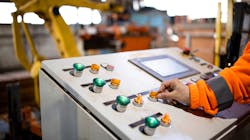One of the very first projects I worked on in the late 1970s, while I was with Allen-Bradley, was with an electrical company in the mining district of Sudbury, Ontario.
Bob fancied himself a pioneer, as he proudly displayed his brand-new Tandy Radio Shack TRS-80 desktop microcomputer complete with dot matrix printer. He was very proud of that beast.
We were working on a Lamacoid mimic panel for a steel company where this panel created on overview of the operation, which included hoppers, temperature gauges, pilot lights, buttons and a panalarm section. It was really quite the thing.
The panel was at least 6 feet long and 6 feet high. It had this new thing called a programmable logic controller (PLC) in the enclosure, which interfaces with the field instruments and process to fire the lights and interface with the alarming system. The PLC wasn’t doing any control, just annunciation.
I remember Bob beaming as the panel left the shop. He wondered out loud if something like the TRS-80 could or would ever be used to replace panels such as the one we just built. Probably not, we joked. The industrial environment is just too tough for a fragile thing like a computer.
That seems funny now, doesn’t it?
This panel was the operator interface for its time, and, as we know, time can march forward with excessive speed.
Enter 1981, when the IBM personal computer (PC) came to be. Apple was first but wasn’t cut out to be anything other than a console.
The industrialization of the PC allowed for many developments. Barry Westhead and Westhead Associates created a customized hardware box for industrial graphics so that industrial processes could be viewed and monitored on a big screen. It was based on a Zilog Z80 microprocessor running on firmware. They migrated to the Control Program/Monitor (CP/M) operating system in later years but got terminated by the movement of technology.
Modicon Modvue was in the mix in the late 1970s and early 1980s, as was Advisor, which was third-party labeled by Allen-Bradley from Dynapro. The hardware, however, was proprietary. Operating systems such as Chronos for Advisor and CP/M for Westhead were more control-friendly.
The IBM PC disk-based operating system (DOS) allowed for a bevy of vendors, such as Steve Rubin’s Intellution, Fastech, ControlView, ViewPoint and the like, to enter the market. It caught on like wildfire. The 1980s were a great time to be in automation graphics. The changing landscape was moving so fast that one had trouble keeping up. Then there was this thing called Windows.
Dennis Morin and his team at Wonderware took over the market for software-based graphical interface. Nematron and Xycom became household names for packaged solutions. Intellution got caught with their hands in their pockets, as did most other graphical solution providers.
Windows changed our world. Imagine a commercially available hardware platform with an operating system that most could get their teeth into and installing software that allows us to build our own views and communicate with our control devices in somewhat real-time. Boom goes the dynamite.
There was no longer a need for panel displays at all. We just needed the hardware to run the software as it gets developed. Hardware came first, and then software rode that wave. We needed gobs of memory and hard-drive space and speed to get done what we needed. And it came in droves.
Once the secondary market got ahold of the IBM patents and design, which IBM made public, the race was on. Designs allowed for huge gains in software, which came quickly in the 1990s and early 2000s. As a result, I don’t think there are any hardware limitations on anything that you may want to accomplish.
Ethernet allows for real-time communication as such. Time-sensitive networking (TSN) will have an impact on display refresh and control algorithms. Mobility on operator interfaces allows for your imagination to go wild.
The pioneers of the graphics industry have all but disappeared. Their innovations have been gobbled up by corporations in America and Europe. While there are lots of vendors creating products, most ride the wave.
Innovation has been here and gone, in my view. Databases in the cloud, message queuing telemetry transport (MQTT) for the Industrial Internet of Things (IIoT) and always-available data are awesome, but the root graphic displays and content are somewhat mundane.
There are some new thought leaders coming to market along with some new opportunities to create innovation in a very mature marketplace. The HMI/SCADA graphics market, which handles most data in most processes, is moving out to the edge. Devices are changing, locations are scattered, but the operation remains the same.
I am looking forward to the new paradigm of operator interface, which we haven’t seen yet.
About the Author

Jeremy Pollard
CET
Jeremy Pollard, CET, has been writing about technology and software issues for many years. Pollard has been involved in control system programming and training for more than 25 years.

Leaders relevant to this article:
